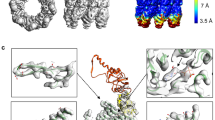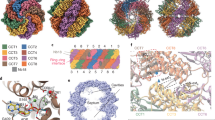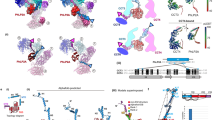Abstract
The eukaryotic cytoplasmic chaperonin containing TCP-1 (CCT) is a hetero-oligomeric complex that assists the folding of actins, tubulins and other proteins in an ATP-dependent manner. To understand the allosteric transitions that occur during the functional cycle of CCT, we imaged the chaperonin complex in the presence of different ATP concentrations. Labeling by monoclonal antibodies that bind specifically to the CCTα and CCTδ subunits enabled alignment of all the CCT subunits of a given type in different particles. The analysis shows that the apo state of CCT has considerable apparent conformational heterogeneity that decreases with increasing ATP concentration. In contrast with the concerted allosteric switch of GroEL, ATP-induced conformational changes in CCT are found to spread around the ring in a sequential fashion that may facilitate domain-by-domain substrate folding. The approach described here can be used to unravel the allosteric mechanisms of other ring-shaped molecular machines.
This is a preview of subscription content, access via your institution
Access options
Subscribe to this journal
Receive 12 print issues and online access
$189.00 per year
only $15.75 per issue
Buy this article
- Purchase on Springer Link
- Instant access to full article PDF
Prices may be subject to local taxes which are calculated during checkout




Similar content being viewed by others
Change history
13 February 2005
Sentences changed in Methods section
Notes
*Note: In the version of this article originally published online, a mistake was introduced during the production process. This mistake occurs in the last paragraph before the Methods section. The correct first four sentences in this paragraph should read “Our results indicate two important differences between CCT and GroEL that probably have functional importance. First, considerable apparent conformational heterogeneity is seen in the apo state of CCT, but not in GroEL. This heterogeneity decreases with increasing ATP concentration and may reflect protein substrate specificity of different CCT subunits in the protein substrate acceptor state of CCT. Second, our results indicate that the ATP-induced conformational changes in CCT take place in a sequential manner according to the KNF model20, in contrast with the concerted mechanism observed in the case of GroEL.” This error has been corrected for the HTML and print versions of the article. We apologize for any inconvenience this may have caused.
References
Llorca, O. et al. 3D reconstruction of the ATP-bound form of CCT reveals the asymmetric folding conformation of a type II chaperonin. Nat. Struct. Biol. 6, 639–642 (1999).
Ranson, N.A. et al. ATP-bound states of GroEL captured by cryo-electron microscopy. Cell 107, 869–879 (2001).
Horovitz, A., Fridmann, Y., Kafri, G. & Yifrach, O. Review: Allostery in chaperonins. J. Struct. Biol. 135, 104–114 (2001).
Saibil, H.R., Horwich, A.L. & Fenton, W.A. Allostery and protein substrate conformational change during GroEL/GroES-mediated protein folding. Adv. Protein Chem. 59, 45–72 (2002).
Bukau, B. & Horwich, A.L. The Hsp70 and Hsp60 chaperone machines. Cell 92, 351–366 (1998).
Thirumalai, D. & Lorimer, G.H. Chaperonin-mediated protein folding. Annu. Rev. Biophys. Biomol. Struct. 30, 245–269 (2001).
Saibil, H.R. & Ranson, N.A. The chaperonin folding machine. Trends Biochem. Sci. 27, 627–632 (2002).
Gutsche, I., Essen, L.O. & Baumeister W. Group II chaperonins: new TRiC(k)s and turns of a protein folding machine. J. Mol. Biol. 293, 295–312 (1999).
Valpuesta, J.M., Martin-Benito, J., Gomez-Puertas, P., Carrascosa, J.L. & Willison, K.R. Structure and function of a protein folding machine: the eukaryotic cytosolic chaperonin CCT. FEBS Lett. 529, 11–16 (2002).
Spiess, C., Meyer, A.S., Reissmann, S. & Frydman, J. Mechanism of the eukaryotic chaperonin: protein folding in the chamber of secrets. Trends Cell Biol. 14, 598–604 (2004).
Liou, A.K.F. & Willison, K.R. Elucidation of the subunit orientation in CCT (chaperonin containing TCP1) from the subunit composition of CCT micro-complexes. EMBO J. 16, 4311–4316 (1997).
Llorca, O. et al. Eukaryotic type II chaperonin CCT interacts with actin through specific subunits. Nature 402, 693–696 (1999).
Braig, K. et al. The crystal structure of the bacterial chaperonin GroEL at 2.8 Å. Nature 371, 578–586 (1994).
Ditzel, L. et al. Crystal structure of the thermosome, the archaeal chaperonin and homolog of CCT. Cell 93, 125–138 (1998).
Yifrach, O. & Horovitz, A. Nested cooperativity in the ATPase activity of the oligomeric chaperonin GroEL. Biochemistry 34, 5303–5308 (1995).
Yifrach, O. & Horovitz, A. Allosteric control by ATP of non-folded protein binding to GroEL. J. Mol. Biol. 255, 356–361 (1996).
Horovitz, A. & Yifrach, O. On the relationship between the Hill coefficients for steady-state and transient kinetic data: a criterion for concerted transitions in allosteric proteins. Bull. Math. Biol. 62, 241–246 (2000).
Ma, J., Sigler, P.B., Xu, Z. & Karplus, M. A dynamic model for the allosteric mechanism of GroEL. J. Mol. Biol. 302, 303–313 (2000).
Monod, J., Wyman, J. & Changeux, J.-P. On the nature of allosteric transitions: a plausible model. J. Mol. Biol. 12, 88–118 (1965).
Koshland, D.E. Jr., Né methy, G. & Filmer, D. Comparison of experimental binding data and theoretical models in proteins containing subunits. Biochemistry 5, 365–385 (1966).
Kafri, G., Willison, K.R. & Horovitz, A. Nested allosteric interactions in the cytoplasmic chaperonin containing TCP-1. Protein Sci. 10, 445–449 (2001).
Kafri, G. & Horovitz, A. Transient kinetic analysis of ATP-induced allosteric transitions in the eukaryotic chaperonin containing TCP-1. J. Mol. Biol. 326, 981–987 (2003).
Melki, R., Batelier, G., Soulié, S. & Williams, R.C. Jr. Cytoplasmic chaperonin containing TCP-1: structural and functional characterization. Biochemistry 36, 5817–5826 (1997).
Lin, P. & Sherman, F. The unique hetero-oligomeric nature of the subunits in the catalytic cooperativity of the yeast Cct chaperonin complex. Proc. Natl. Acad. Sci. USA 94, 10780–10785 (1997).
Hynes, G., Kubota, H. & Willison, K.R. Antibody characterisation of two distinct conformations of the chaperonin-containing TCP-1 from mouse testis. FEBS Lett. 358, 129–132 (1995).
Frank, J. Three-dimensional Electron Microscopy of Macromolecular Assemblies (Academic Press, San Diego, 1996).
Llorca, O. et al. Eukaryotic chaperonin CCT stabilizes actin and tubulin folding intermediates in open quasi-native conformations. EMBO J. 19, 5971–5979 (2000).
Danziger, O., Rivenzon-Segal, D., Wolf, S.G. & Horovitz, A. Conversion of the allosteric transition of GroEL from concerted to sequential by the single mutation Asp-155→Ala. Proc. Natl. Acad. Sci. USA 100, 13797–13802 (2003).
Llorca, O. et al. ATP binding induces large conformational changes in the apical and equatorial domains of the eukaryotic chaperonin containing TCP-1 complex. J. Biol. Chem. 273, 10091–10094 (1998).
Meyer, A.S. et al. Closing the folding chamber of the eukaryotic chaperonin requires the transition state of ATP hydrolysis. Cell 113, 369–381 (2003).
Llorca, O. et al. The 'sequential allosteric ring' mechanism in the eukaryotic chaperonin-assisted folding of actin and tubulin. EMBO J. 20, 4065–4075 (2001).
Hynes, G.M. & Willison, K.R. Individual subunits of the eukaryotic cytosolic chaperonin mediate interactions with binding sites located on subdomains of β-actin. J. Biol. Chem. 275, 18985–18994 (2000).
Netzer, W.J. & Hartl, F.U. Recombination of protein domains facilitated by co-translational folding in eukaryotes. Nature 388, 343–349 (1997).
Ludtke, S.J., Jakana, J., Song, J.-L., Chuang, D.T. & Chiu, W. A 11.5 Å single particle reconstruction of GroEL using EMAN. J. Mol. Biol. 314, 253–262 (2001).
Frank, J., Shimkim, B. & Dowse, H. SPIDER: a modular software system for electron image processing. Ultramicroscopy 6, 343–358 (1981).
Davies, D.L. & Bouldin, D.W. A cluster separation measure. IEEE Trans. Pattern Anal. Machine Intelligence 1, 224–227 (1979).
Acknowledgements
This work was supported by The Israel Science Foundation. D.R.-S is a recipient of a Phil Zacharia postdoctoral fellowship. A.H. is an incumbent of the Carl and Dorothy Bennett Professorial Chair in Biochemistry. K.R.W. is supported by Cancer Research UK. We thank the Institute of Cancer Research Hybridoma Unit for monoclonal antibody production and A. Friesem and A. Pe'er for useful discussion.
Author information
Authors and Affiliations
Corresponding author
Ethics declarations
Competing interests
The authors declare no competing financial interests.
Rights and permissions
About this article
Cite this article
Rivenzon-Segal, D., Wolf, S., Shimon, L. et al. Sequential ATP-induced allosteric transitions of the cytoplasmic chaperonin containing TCP-1 revealed by EM analysis. Nat Struct Mol Biol 12, 233–237 (2005). https://doi.org/10.1038/nsmb901
Received:
Accepted:
Published:
Issue Date:
DOI: https://doi.org/10.1038/nsmb901
This article is cited by
-
Pathway and mechanism of tubulin folding mediated by TRiC/CCT along its ATPase cycle revealed using cryo-EM
Communications Biology (2023)
-
A Review: Molecular Chaperone-mediated Folding, Unfolding and Disaggregation of Expressed Recombinant Proteins
Cell Biochemistry and Biophysics (2021)
-
Identification of an allosteric network that influences assembly and function of group II chaperonins
Nature Structural & Molecular Biology (2017)
-
CCT2 Mutations Evoke Leber Congenital Amaurosis due to Chaperone Complex Instability
Scientific Reports (2016)
-
Internal (His)6-tagging delivers a fully functional hetero-oligomeric class II chaperonin in high yield
Scientific Reports (2016)



